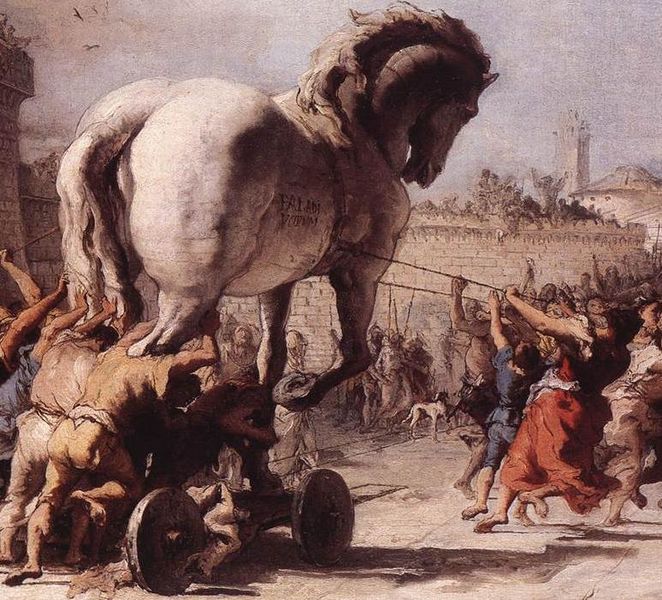or Christianity and Jewry
by Savitri Devi [1]
 If there is a fact that cannot fail to impress all persons who seriously study the history of Christianity, it is the almost complete absence of documents regarding the man whose name the great international religion bears, namely Jesus Christ.
If there is a fact that cannot fail to impress all persons who seriously study the history of Christianity, it is the almost complete absence of documents regarding the man whose name the great international religion bears, namely Jesus Christ.
We only know of him from what is told to us in the gospels, i.e., practically nothing, for these miscellanies, if prolix in their descriptions of the miraculous facts they concern, give no information at all about his person, and, in particular, about his origins. Oh, we have in the four canonical gospels a long genealogy going back from Joseph, the husband of the mother of Jesus, as far as Adam!
But I always ask myself what interest this can have for us, given that elsewhere we are expressly told that Joseph has nothing to do with the birth of the child. One of the numerous “apocryphal” gospels—rejected by the church—attributes the paternity of Jesus to a Roman soldier distinguished for his bravery and thus nicknamed “The Panther.” This gospel is cited by Heckel in one of his studies of early Christianity. [2]
The acceptance of this point of view, however, does not entirely resolve the very important question of the origins of Christ, for it does not tell us who was Mary his mother. One of the four canonical gospels tells us that she was the daughter of Joachim and Anne when Anne was past the age of maternity; in other words, she was herself born miraculously—or she was quite simply a child adopted by Anne and Joachim in their old age—which does not clarify matters.
But there is something much more troubling. They have recently discovered the records of an important monastery of the Essene sect, situated scarcely thirty kilometers from Jerusalem. These records deal with a period extending from the beginning of the first century before Jesus Christ to the second half of the first century after him.
There is already talk, seventy years before him, of a great Initiate, or a Spiritual Master—the “Master of Justice”—whose return one day is awaited. Of the extraordinary career of Jesus, of his innumerable miraculous healings, of his teaching during three whole years in the midst of the people of Palestine, of his triumphant entry into Jerusalem, so brilliantly described in the canonical gospels, of his trial and crucifixion (accompanied according to the canonical gospels by events as impressive as an earthquake, the darkening of the sky for three hours in the afternoon, and the veil of the temple rending itself in two), not one word is said in the scrolls of these ascetics—eminently religious men, whom such events would have to interest.
It seems, according to these “Dead Sea Scrolls”—I recommend to those who take interest in this matter to read the study which has been published by John Allegro in the English language [3]—or else Jesus did not produce any impression on the religious minds of his time, as avid for wisdom and also as well informed as the ascetics of the monastery in question appear to have been, or else… he simply did not exist at all! As troubling as it may be, these findings should be placed before the world public, and in particular the Christian public, after these recent discoveries.
In that which concerns the Christian church, however, and Christianity as an historical phenomenon, and the role that it plays in the West and in the world, the question has much less importance than it would seem at first.
For even if Jesus had lived and preached, it is not he who is the true founder of Christianity as he is presented to the world. If he truly lived, Jesus was a man “above Time” whose kingdom—as he himself said to Pilate, according to the gospels—is “not of this world,” whose entire activity, entire teaching, tended to show, to those whom the world did not satisfy, a spiritual path by which they can escape, and find, in their interior paradise, in this “Kingdom of God” which is in us, the God “in spirit and in truth” whom they seek without knowing. [4]
If he had lived, Jesus would never have dreamed of founding a temporal organization—and, above all, not a political and financial organization—such as the Christian Church so quickly became. Politics did not interest him.
And, detesting riches, he was a determined enemy of any mixture of money in spiritual affairs, which certain Christians have, rightly or wrongly, seen as an argument that proves that, contrary to the teaching of all Christian Churches (except those which absolutely negate his human nature [For example, the sect of the Monophysites]), he did not have Jewish blood.
The true founder of historical Christianity, of Christianity that we know in practice, which has played and will play a role in the history of the West and the world, is neither Jesus, whom we know not at all, nor his disciple Peter, whom we know was Galilean and a simple fisherman in station, but Paul of Tarsus, whom we know was 100% Jewish in blood, in disposition, and in his heart, and, what is more, Jewish in education and a “Roman citizen,” as so many Jewish intellectuals today are French, German, Russian, or American citizens.
Historical Christianity—which is not at all a work “above Time,” but altogether a work “in Time”—is the work of Saul, called Paul, that is to say, the work of a Jew, as Marxism came to be more than two thousand years later. Let us examine the career of Paul of Tarsus.
Saul, called Paul, was a Jew and, what is more, an orthodox Jew at the same time as he was educated, a Jew imbued with the consciousness of his race and the role the “chosen people”—which they became according to the covenant of Jaweh—play in the world.
He was a student of Gamaliel, one of the most reputed Jewish theologians of his time—theologian of the school of Pharisees, precisely the one which, according to the gospels, the prophet Jesus, whom the Christian church later on elevated to the rank of God, had quite violently combated for its arrogance, its hypocrisy, its habit of splitting hairs and putting the letter of the Jewish law before its spirit—before, at least, what he believed to be its spirit; it is not said whether Saul had not had, on this subject, a different idea than him.
Moreover—and this is very important—Saul was an educated and self-conscious Jew born and raised outside of Palestine, in one of those cities of Roman Asia Minor that had succeeded Hellenistic Asia Minor and had retained all its characteristics: Tarsus, where Greek was the “lingua franca” of everyone and where Latin became, likewise, more and more familiar, and where one recognized representatives of all the peoples of the Near East.
In other words, he was already a “ghetto” Jew, possessing, beyond a profound knowledge of the Israelite tradition, an understanding of the world of the “Goyim”—the non-Jews—which later on became of great value for him. He thought, without any doubt, like every good Jew, that the “Goy” is only to be dominated and exploited by the “chosen people.” But he knew their world infinitely better than the Jews of Palestine, in the midst of whom had emerged all the first believers of the new religious sect from which he was destined to form Christianity such as we see it.
It is said in the “Acts of the Apostles” that there was at first a ferocious persecution of the new sect. Did the adherents of the latter not scorn the Jewish Law in the strict sense of the word? Did the man who is recognized as the founder, and who is said to have returned from the dead, this Jew whom Saul himself had never seen, not give the example of his non-observance of the Sabbath, of his neglect of the days of fasting, and other strongly blameworthy transgressions of the rules of life from which a Jew should not depart at all?
One may say the same of a mystery that bodes nothing good, hovering over the story of his birth, that he was perhaps not at all of Jewish origin—who knows? Why not persecute any such sect, when one is an orthodox Jew, student of the great Gamaliel? He had to preserve from scandal the observers of the Law.
Saul, who had already given proof of zeal in being present at the stoning of Saint Stephen—one of the first preachers of the dangerous sect—continued to defend the Jewish Law and the tradition against those he considered to be heretics, until it finally dawned on him that there was a better—a much better—way of operating, precisely from the Jewish point of view. This he recognized on the road to Damascus.
The story, as the Christian church wishes it to be told, is that he suddenly had a vision of Jesus—whom he had not, I repeat, ever seen “in the flesh”—whose voice he finally heard say to him: “Saul, Saul, why do you persecute me?,” which voice he could not resist. He had, moreover, been blinded by a dazzling light, and he felt himself thrown to the ground. Transported to Damascus—at least according to the same account in “Acts of the Apostles”—he was recognized by one of the faithful of the sect which he had come to combat, the man who, after restoring Saul’s eyesight, baptized him and received him into the Christian community.
It is superfluous to say that this miraculous account cannot be accepted as it is told except by those who share the Christian faith. It does not have, like all accounts of its type, any historical value. Those who, without preconceived ideas, seek a plausible explanation—probable, natural—of the manner in which these things have happened, cannot be content.
And the explanation, to be plausible, must give an account not only of the transformation of Saul into Paul—of the implacable defender of Judaism into the founder of the Christian church as we know it—but also of the nature, the content, and the direction of his activity after his conversion, of the internal logic of his career; otherwise put, the psychological connection, more or less conscious, between his past anti-Christianity and his great Christian work.
Every conversion implies a connection between the past of the convert and the rest of his life, a deep reason, that is to say, a permanent aspiration of the convert that the act of conversion satisfies, a will, a permanent direction of life and action, of which the act of conversion is the expression and the instrument.
Now, given all we know of him and above all of the course of his career, there is only one profoundly fundamental will, inseparable from the personality of Paul of Tarsus in all the stages of his life, which can furnish the explanation for his “road to Damascus,” and this will is the one that serves the old Jewish ideal of spiritual domination, complementing and crowning that of economic domination.
Saul, orthodox Jew, self-conscious Jew, who had combated the new sect insofar as it constituted a danger to orthodox Jewry, could only renounce his orthodoxy and become the soul and the arm precisely of this dangerous sect, after having understood that, recast by him, transformed, adapted to the exigencies of the vast world of the “Goyim”—the “Gentiles” of the gospels—interpreted, as he did, in the manner of giving, as said later on by Nietzsche, “a new meaning to the ancient mysteries,” it could become for centuries, if not forever, the most powerful instrument of the spiritual domination of Israel, the way by which it realizes, the most certainly and in the most definitive manner, the “mission” of the Jewish people, which was, according to him, as according to every good Israelite, that of ruling over the other peoples, subjecting them to a complete moral enslavement while exploiting them economically.
And the more moral enslavement is complete, the more economic exploitation—it goes without saying—flourishes. It is only this prize that merits the pain of repudiating the rigidity of the ancient and venerable Law.
Or, to speak a more trivial language, the sudden conversion of Saul along the road to Damascus is explicable in a completely natural manner solely if one allows that he suddenly appreciated the possibilities which nascent Christianity offered him for profit in the moral domination of his people, and which he had thought—in a stroke of genius, it might be said—“How I have taken the short view in persecuting this sect instead of serving mine come what may! How foolish I have been to attach myself to the forms—the details—instead of seeing the essential: the interest of the people of Israel, of the chosen people, of our people, of us Jews!”
The whole subsequent career of Paul is an illustration—a proof, to the extent that one may propose to “prove” facts of this nature—of this ingenious change of course, of this victory of an intelligent Jew, a practical man, a diplomat (and when “diplomat” is said in connection with religious questions, deception is meant) over the orthodoxly educated Jew preoccupied above all with the problems of ritual purity.
From the day of his conversion, Paul, in effect, abandoned himself to the “Spirit,” and went where the “Spirit” suggested, or rather ordered, him to go, and spoke, in every circumstance, the words that the “Spirit” inspired in him. But where did the “Spirit” “order” him to go? To Palestine, among the Jews who still took part in the “errors” which he had publicly abjured, and who seemed to be the first to have title to the new revelation? Not on your life! He was quite careful!
It was in Macedonia, as it was in Greece and among the Greeks of Asia Minor, among the Galatians, and later among the Romans—in Aryan lands: on the whole, in non-Jewish lands—that the neophyte went forth to preach the theological dogmas of original sin and eternal salvation through Jesus crucified, and the moral dogma of the equality of all men and of all peoples: it was in Athens where he proclaimed that God had created “all the nations, all the peoples, of one and the same blood” (“Acts of the Apostles,” chapter 17, verse 26).
With this negation of the natural hierarchy of races, the Jews, had nothing to do—they who have, at all times, in their conception of the world, overturned this hierarchy to their profit. But it was (from the Jewish point of view) very useful to preach, to impose on the “Goyim,” to destroy their national values that had, up to that point, made them strong (or, rather, to simply hasten their destruction; for since the fourth century before Jesus Christ, they were already crumbling under the influence of the “hellenized” Jews of Alexandria).
Without a doubt, Paul also preached it “in the Synagogues,” that is to say, to Jews, to whom he presented the new doctrine as the fulfillment of the prophecies and the messianic expectation; without a doubt, he said to these sons of his people, as to the “God fearers”—to semi-Jews, like Timothy, and to the Jewish quarters which were abundant in the Aegean seaports (the same as in Rome)—that Christ crucified and resurrected, whom he announced, was none other than the promised messiah.
He gave a new meaning to the Jewish prophets, just as he gave a new meaning to the immemorial mysteries of Greece, Egypt, Syria, and Asia Minor: a meaning that attributes a unique role, a unique place, a unique importance to the Jewish people in the religion of non-Jews. It was for him nothing but a means to the end of assuring for his people the spiritual domination of future ages. His genius—not religious, but political—consists in having understood this.
But it is not solely in the plan of the doctrine where he can show a disconcerting suppleness—“Greek with the Greeks, and Jew with the Jews,” as he himself said. He has a sense of practical necessities—and impossibilities. He who was at first so orthodox, is the first to oppose completely the imposition of the Jewish Law on Christian converts of non-Jewish races.
He insists—against Peter and the least conciliatory group of the first Christians of Jerusalem—on the fact that a Christian of non-Jewish origin does not at all require circumcision or the Jewish laws concerning diet.
He wrote for these new converts—half-Jews, half-Greeks, Romans of dubious origin, Levantines from all the parts of the Mediterranean: for all of this world without race, with which he served as the intermediary with his Jewish people, immutable in their tradition, and the vast world to conquer—where there does not exist, for them, the distinction between that which is “pure” and that which is “impure,” where they are permitted to eat anything (“all that which can be found in the market-place”).
He knew that, without these concessions, Christianity could not expect to conquer the West—nor the Jews expect to conquer the world by means of the conversion of the West.
Peter, who was not at all a Jew of the “ghetto,” still did not understand at all the conditions of a non-Jewish world and did not see things from the same point of view—not yet anyway.
It is because of this that it is necessary to see in Paul the true founder of historical Christianity: the man who made the purely spiritual teaching of the prophet Jesus the basis of a militant organization in Time, the goal of which is nothing but the domination of the Jews over a morally emasculated and physically debased world, a world where the mistaken love of “man” leads straight to the indiscriminate mixing of races, to the suppression of every national pride, and, in a word, to the degeneration of man.
It is time that all the non-Jewish nations finally open their eyes to this reality of two thousand years. May they understand the striking present day situation and react accordingly.
Written in Méadi (near Cairo), 18 June 1957 [5]
______________
[1] Originally published as Paul de Tarse, ou Christianisme et juiverie (Calcutta: Savitri Dêvi Mukherji, 1958). Translated from the French by R.G. Fowler, with thanks to M.L., J.P., and D.O.
[2] Savitri may be referring to Ernst Haeckel, who mentions Pandera in his chapter on “Science and Christianity” in his The Riddle of the Universe at the Close of the Nineteenth Century, trans. Joseph McCabe (New York: Harper and Brothers, 1900), 328-9.
[3] Savitri may be referring to any one of the following volumes by John Allegro: The Dead Sea Scrolls (Harmondsworth, England: Penguin, 1956), The Mystery of the Dead Sea Scrolls Revealed (New York: Gramercy, 1956), or, if it was published by the time of the essay’s composition, The Dead Sea Scrolls and the Origins of Christianity (New York: Criterion, 1957). In Pilgrimage, Savitri refers to another book on early Christianity by Gerald Massey, The Historical Jesus and the Mythical Christ (Springfield: Star Publishing Company, n.d.). See Savitri Devi, Pilgrimage (Calcutta: Savitri Devi Mukherji, 1958), 332.
[4] In The Lightning and the Sun (Calcutta: Savitri Devi Mukherji, 1958), Savitri makes a threefold distinction between men “above Time,” “in Time,” and “against Time.” Men above Time are visionaries and prophets who orient themselves by truths that transcend the present world. They are, therefore, impractical when it comes to changing the present world. Men in Time are entirely creatures of the present world. Therefore, they are more capable of attaining worldly success. Men against Time orient themselves by truths that transcend the present, yet they are capable of operating within the world to advance the cause of truth. Savitri offers the Pharaoh Akhnaton as the paradigm of the man above Time, Genghis Khan as the paradigm of the man in Time, and Hitler as the paradigm of the man against Time.
[5] In May of 1957, Savitri sailed to Egypt en route to India. She stayed in the Cairo suburb of El-Maâdi in the home of Mahmoud Saleh, a Palestinian Arab and Nazi sympathizer. Saleh was a friend and neighbor of Nazi exile Johannes von Leers (1902-1963), a former German university professor and member of the SS who had been employed by Goebbels’ Ministry of Propaganda and was later employed by the Nasser government as a specialist in Zionist affairs. Savitri spent a good deal of her time in Egypt in Leers’ company. See Nicholas Goodrick-Clarke, Hitler’s Priestess: Savitri Devi, The Hindu-Aryan Myth, and Neo-Nazism (New York: New York University Press, 1998), 176-9. Savitri relates some of the events of her stay in Egypt in Long-Whiskers and the Two-Legged Goddess: or the true story of a “most objectionable Nazi” and . . . half-a-dozen cats (Calcutta: Savitri Devi Mukherji, n.d. [actually published in England circa 1965]), 97-99.







